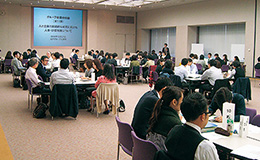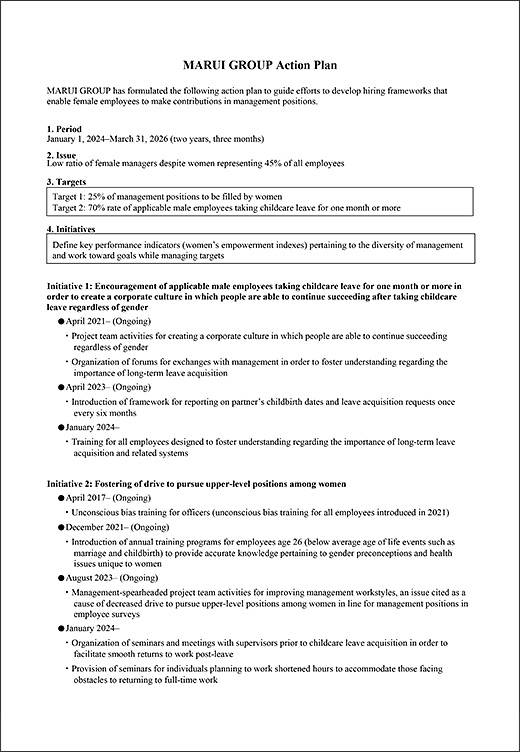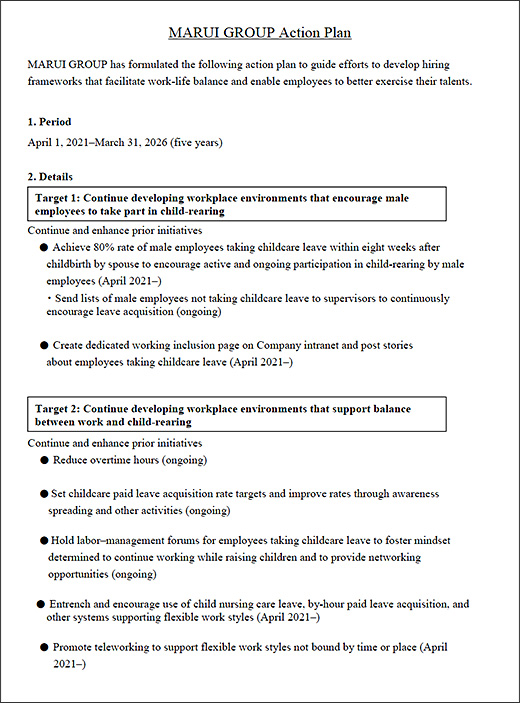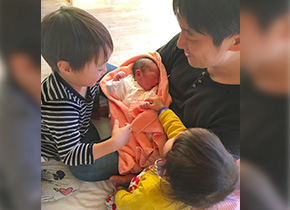Development of an Organization that Utilizes Diversity
- Three Themes for Promoting Diversity
- Innovation and Evolution of Diversity Promotion Initiatives
- Approach toward Promoting Diversity
- Human Resource and Evaluation Systems
- Work Style Reforms
- Promotion of Women's Contributions
- Initiatives for Helping Employees Balance Their Work with Childrearing
- Initiatives for Supporting Working While Providing Long-Term Care
- Initiatives for Achieving 100% Rate of Male Employees Taking Childcare Leave
- Work-Life Balance Systems
- Promotion of Paid Vacation Day Acquisition
- Promotion of Employment of Differently Abled Individuals
- Promotion of an LGBTQ-Friendly Atmosphere
- Reemployment Support System
Human Resource and Evaluation Systems
A Groupwide committee was assembled in December 2015 to examine the Group's human resource and evaluation systems. To date, this committee has held discussions on the implementation of these systems and their quantitative and qualitative targets with a total of 2,600 representatives from the employee base and from the Personnel Division. Based on these discussions, we launched new systems centered on value evaluations, which assess employees based on the sensibilities necessary for exercising our management philosophy and how well they are suited to each position, and performance evaluations, which look at the results of teams over a given period.

Work Style Reforms
Options for Flexible Work Styles
MARUI GROUP introduced a system that allows employees to work shortened hours in April 2021. Moreover, we have granted employees an additional day off that can be used for self-improvement, child-rearing, or long-term care purposes with the aim of helping employees better grow while working.
Meanwhile, the flextime system introduced in April 2022 enables employees to autonomously manage their monthly work hours, a move we anticipate will contribute to improved results and a greater degree of work–life balance.
Teleworking
MARUI GROUP encourages employees to utilize teleworking as a new work style for mobilizing diverse human resources and heightening individual productivity. This recommendation is being backed by efforts to develop a workplace environment in which employees feel safe teleworking. Measures to this end have included establishing teleworking regulations and providing employees with teleworking allowances.
Promotion of Women's Contributions
As of March 31, 2023, MARUI GROUP had 2,009 female employees, representing 45% of its total of 4,435 employees. We are promoting the contributions of women by developing support systems and improving awareness. In the fiscal year ended March 31, 2014, we defined women's empowerment indexes for measuring our progress in this regard and set targets to be achieved by the fiscal year ended March 31, 2021. As a result of these efforts, the rate of recognition of contributions of female employees has risen to 99%, while the ratio of applicable male employees taking childcare leave has remained at 100% for the third consecutive year in the aforementioned fiscal year. Upward trends were seen in other indexes, but we were unable to achieve our targets for the fiscal year ended March 31, 2021, for these indexes.
Women's Empowerment Indexes
| FY2017 | FY2018 | FY2019 | FY2020 | FY2021 | vs. Target | FY2021 (Target) | ||
|---|---|---|---|---|---|---|---|---|
| Awareness improvement and corporate culture cultivation | Recognition of contributions of female employees*1 | 96% | 97% | 98% | 99% | 99% | 1 percentage point less | 100% |
| Ratio of female employees pursuing upper-level positions*2 | 64% | 67% | 69% | 67% | 70% | 10 percentage point less | 80% | |
| Ratio of applicable male employees taking childcare leave*3 | 74% | 84% | 100% | 100% | 100% | Achieved | 100% | |
| Promotion of women's contributions | Ratio of female employees returning to work full time after taking childcare leave*4 | 81% | 63% | 74% | 64% | 59% | 31 percentage point less | 90% |
| Number of female leaders*5 | 611 | 643 | 576 | 657 | 668 | 232 people less | 900 | |
| Number of female managers*5 *6 | 32 | 40 | 46 | 49 | 50 | 5 people less | 55 | |
| Ratio of female managers*5 *6 | 10% | 11% | 12% | 14% | 14% | 3 percentage point less | 17% | |
- *1 Recognition of contributions of female employees is based on the results of the employee surveys conducted in the respective fiscal years. (The ratio is calculated as the ratio of employees that responded to the "I understand the purpose and necessity of promoting diversity" question with either "Understand well" or "Understand somewhat.")
- *2 Ratio of female employees pursuing upper-level positions is based on the results of surveys.
- *3 Ratio of applicable male employees taking childcare leave is calculated using the number of individuals who had a partner give birth in the previous fiscal year and who took childcare leave in both the previous fiscal year and the given fiscal year.
- *4 Ratio of female employees returning to work full time after taking childcare leave is the ratio of female employees returning to work full time to the total number of female employees that returned to work shortened hours after childcare leave within a given year.
- *5 Figures are as of April 1 of the given year.
- *6 Figures exclude external directors.
New Women's Empowerment Indexes
The period for the previous women's empowerment indexes concluded with the fiscal year ended March 31, 2021. We failed to meet the target for the ratio of female managers. This failure is thought to be a result of a lack of female employees pursuing upper-level positions. Preconceptions about gender roles are a major barrier to the advancement of female employees. Recognizing this fact, MARUI GROUP launched an initiative aimed at reforming awareness among both female and male employees for the purpose of eliminating such preconceptions. New women's empowerment indexes and associated targets were defined based on this initiative. We have reached 100% aqisition of male employees taking childcare leave for five consecutive years, and a corporate culture of taking paternity leave has taken root. However, we believe that taking childcare leave for a certain period immediately after childbirth is necessary for couples to sustainably balance work and family life, so we have set new items: "Ratio of male employees taking childcare leave within eight weeks of childbirth by partner" and "Ratio of applicable male employees taking childcare leave for one month or more."The period for these indexes and targets concludes on the fiscal year ending March 31, 2026.
Note: The targets for the ratio of applicable male employees taking childcare leave within eight weeks of childbirth by partner, the ratio of applicable male employees taking childcare leave for one month or more, and the ratio of female managers were achieved in the fiscal year ended March 31, 2023, and are anticipated to be achieved in the fiscal year ending March 31, 2024. Accordingly, upward revisions to the targets for these items were made in January 2024.
| Index | FY2022 | FY2023 | FY2025 (Target) |
FY2025 (Revised Targets) |
|
|---|---|---|---|---|---|
| Rate of elimination of gender preconceptions (ratio of employees rejecting preconceptions about gender roles)*1 |
53% | 56% | 50% | 50% | |
| Ratio of applicable male employees taking childcare leave*2 | 100% | 100% | 100% | 100% | |
| Ratio of applicable male employees taking childcare leave within eight weeks of childbirth by partner | 78% | 97% | 80% | 95% | Revised |
| Ratio of applicable male employees taking childcare leave for one month or more | 22% | 52% | 20% | 70% | Revised |
| Rate of household chore and child-rearing participation by male employees*3 | 27% | 31% | 35% | 35% | |
| Ratio of female employees pursuing upper-level positions*4 (Ratio of male employees pursuing upper-level positions)*5 |
62% (82%) |
58% (79%) |
75% (—) |
75% (—) |
|
| Ratio of female leaders*6*8 | 34% | 36% | 40% | 40% | |
| Ratio of female managers*7*8 | 18% | 21% | 20% | 25% | Revised |
| Ratio of women in executive officer positions*8 | 21% | 20% | 30% | 30% |
- *1 Figures represent the ratio of employees rejecting preconceptions about gender roles in internal surveys.
- *2 Figures represent the number and ratio of male employees whose partner gave birth two fiscal years ago and who took childcare leave (including other leave taken for childcare purposes) in the past two fiscal years.
- *3 Time spent by men on household chores and child-rearing ÷ (Time spent by men on household chores and child-rearing + Time spent by women on household chores and child-rearing) (based on internal survey results)
- *4 Figures represent the ratio of female employees stating a desire to reach higher position grades or somewhat in internal surveys.
Based on our trends, 70% of employees aged 55 and above don't pursue upper-level positions for "retirement age" as the primary reason, the calculation target has been changed to 54 years old and under from the disclosure of the fiscal year ended March 31, 2024.
(Figures from previous years have been restated to reflect this change.) - *5 Compared to FY ended March 31, 2020, before the COVID-19 pandemic, there has been a decline in number of employees who pursues upper-level positions by 10% for female (from 68% in FY ended March 31, 2020) and 9% (from 88% in FY ended March 31, 2020) for male. We’ve investigated for the causes of this trend and revealed that the COVID-19 pandemic has triggered a shift in work values for both genders, with increased emphasis on telecommuting and work-life balance, etc. In order to enhance the number of employees that aspires upper-level positions, we will further implement work styles reforms and provide supports for work-life balance for not only for female but also for male employees. As part of this effort, we have added the ratio of male employees who pursuits upper-level positions from the disclosure of March 2024.
- *6 Figures represent the ratio of female employees in pre-management positions (G3 and G4).
- *7 Figures represent the ratio of female employees in director, executive officer, and other management positions.
- *8 Figures are as of April 1 of each year.
Action Plan for Empowering Female Employees
In accordance with the Act on the Promotion of Women's Active Engagement in Professional, MARUI GROUP has formulated the following action plan* for establishing a workplace environment that enables female employees to continue working and to make contributions in managerial roles.
* The action plan was revised in January 2024 following upward revisions to the targets for the Company’s women’s empowerment indexes.
- Business Operator Action Plan Based on the Act on Promotion of Women's Participation and Advancement in the Workplace

The above constitutes the shared action plan that has been submitted based on the Act on Promotion of Women's Participation and Advancement in the Workplace for MARUI GROUP CO., LTD.; MARUI CO., LTD.; Epos Card Co., Ltd.; MOVING CO., LTD.; and all other Group companies.
Action Plan for Supporting the Raising of the Next Generation of Children
MARUI GROUP has formulated an action plan for establishing a workplace environment that supports employees in balancing their work and their childrearing efforts in accordance with the Act on Advancement of Measures to Support Raising Next-Generation Children.
- Business Operator Action Plan Based on the Act on Advancement of Measures to Support Raising Next-Generation Children

The above constitutes the shared action plan that has been submitted based on the Act on Advancement of Measures to Support Raising Next-Generation Children for MARUI CO., LTD.; Epos Card Co., Ltd.; MOVING CO., LTD.; and all other Group companies.
Initiatives for Helping Employees Balance Their Work with Childrearing
MARUI GROUP has in place systems that support employees in working while giving birth and raising children. Accordingly, employees at the Company are able to develop their careers with peace of mind as they undergo various life events after joining. We have introduced a system that enables employees to work full time up to four days a month while still using the shortened work hour systems as well as a time period-limited full-time work system that allows employees to choose to work only during specific time periods, even at stores that are open until late hours. In these ways, we are advancing a concerted Group effort to create an environment in which employees can actively contribute while raising children.

-
Special daycare services provided on days of communication forums for employees returning to work from childcare leave*
* Special daycare services were not provided on the days of the communication forums in the fiscal year ended March 31, 2022, as the forums were held online in response to the COVID-19 pandemic.
Career Design Program
The Career Design Program is an initiative meant to provide employees age 26 with opportunities to think about their career. Comprising seminars by external instructors and panel discussions by more experienced employees, this program aims to help people continue to contribute in their own unique manner, even while undergoing life events.
Communication Forums for Employees Returning to Work from Childcare Leave
(Held Jointly with Companies and MARUI GROUP UNION)
Communication forums for employees returning to work from childcare leave are held once a year for individuals taking maternity leave or childcare leave. These forums provide an opportunity for employees to learn about the state of their company and its human resources systems and to share information and opinions with mothers that are currently working while raising children. The forums thereby help participants alleviate their concerns and make new discoveries.
Communication Forums for Working Mothers
(Held Jointly with Companies and MARUI GROUP UNION)
Communication forums for mothers working shortened hours are held once a year to provide working mothers with opportunities to gain ideas on how to feel more empowered in their work and to think about their future careers. These forums consist of presentations by outside lecturers and theme-based discussions as well as exchanges of information and opinions among participants. As such, the forums help participants make new discoveries while increasing their motivation toward their work.
Note: Following progress in eliminating gender preconceptions, communication forums for employees returning to work from childcare, communication forums for individuals working shortened hours, and Career Design Program events were made open to male employees as well as internal and external partners in the fiscal year ended March 31, 2022.
Initiatives for Supporting Working While Providing Long-Term Care
As the population of Japan continues to age, it can be expected that there will be a rise in the number of MARUI GROUP employees needing to provide long-term care to family members. To allow such employees to feel empowered in their work, we have introduced leave and shortened working hour systems for long-term care purposes among other initiatives for supporting working while providing care.
KAIGO Forum (Joint Initiative Between MARUI GROUP and MARUI GROUP UNION)
In 2020, MARUI GROUP began holding KAIGO Forum seminars open to participation from employees currently providing long-term care to family members, employees who may be required to do so in the future, and the supervisors of teams with care-providing members.
These seminars are designed to help participants gain ideas about how to balance work with care giving while also providing opportunities to alleviate stress and gain new insights through exchanges of information with other participants.

Initiatives for Achieving 100% Rate of Male Employees Taking Childcare Leave
MARUI GROUP encourages male employees to take childcare leave based on the recognition that cooperation from an early stage is imperative to two-parent child-rearing. Male employees are able to acquire leave for up to three years, higher than the legally mandated limit described in child-rearing- and caregiving-related legislation.
Comment from Male Employee Who Acquired Six Months of Childcare Leave


- Koichiro Oshikawa
- Deputy Store Manager, Kokubunji Marui
- Note: Positions are as of the time of the interview.
- I took six months of childcare leave when my third child was born. After the birth of my second child, I only took 10 days of leave, and it was over in a flash. This is why I decided to take a longer leave this time around, so that I could bond better with my family. This ended up being a highly valuable experience as it gave me an opportunity to see my child's development up close and also helped me better understand my wife's struggles. MARUI GROUP arranged numerous opportunities for me to consult with my supervisor in preparation for my long-term leave. During one such consultation, I was advised to act based on my own desires and on the circumstances of my family. Convinced that this leave would be beneficial to me and to the rest of my life, I made my decision. It is surprising how little time you spend really engaging with your children over the course of your life. I therefore hope that others will also utilize MARUI GROUP's leave systems to take part in the precious experience normally only available through childcare leave.
This sustainability website is designed to accommodate people with color blindness.













